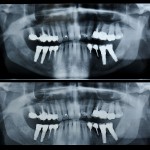
High success rates for dental implants have been demonstrated but a number of factors have been linked to implant failures. These include peri-implant disease, smoking, diabetes, and bisphosphonate use. The aim of this review was to compare marginal bone loss and the failure of implants during different follow-up periods between smokers and non-smokers.
Methods
Searches were conducted in the PubMed, Web of Science, and the Cochrane Central Register of Controlled Trials databases. Prospective and retrospective cohort studies, and randomised trials (RCTs) that compared the marginal bone loss and implant failure rates between smokers and non-smokers were considered. Two reviewers screened the studies, abstracted data and assessed study quality using the Newcastle–Ottawa scale (NOS). Binary and continuous variables from the studies included were analyzed through meta-analysis when the same type of data was assessed by at least two studies. Binary outcomes were reported as odds ratio (OR) and continuous outcomes as standardised mean difference (SMD). Random or fixed effects models were used to pool data.
Results
- 15 studies (5 prospective and 10 retrospective) were included.
- 13 studies scored 6 or more on the NOS so were considered to be of high quality.
- The number of patients ranged from 60 – 1727.
- 5840 implants were placed in smokers, 14683 in non-smokers.
- 10 studies reported a statistically significant difference in the average number of implant failures between smokers and non-smokers.
- 7 studies reported on the analysis of marginal bone loss (MBL).
- MBL ranged from 0.07 to 2.7 mm in smokers and 0.04 to 3.13 mm.
- Meta-analysis found a statistically significant difference in favour of non-smokers. SMD = 0.49 (95% CI; 0.07–0.90 P = 0.02).
- Implant survival ranged from 65.3% to 97% in smokers and 82.7% to 98.8% in non-smokers
- Meta-analysis found a statistically significant increase in implant failure in smokers. OR = 1.96 (95% CI; 1.68–2.30. P < 0.00001).
- Subgroup analysis for follow-up time revealed no significant increase in implant failure proportional to the increase in follow-up time.
Conclusions
The authors concluded:
a statistically significant difference in marginal bone loss was found between the smoking group and the non-smoking group, in favour of the non-smoking group. A statistically significant difference in implant failure in favour of the non-smoking group was also observed. The data in this review should be interpreted with caution because of the selective inclusion of prospective and retrospective cohort studies. A greater number of RCTs based on the CONSORT statement is critical to better understand the correlation between smoking and the success of implants.
Comments
It is interesting to compare this review with one we considered earlier this year on the same topic (Dental Elf -13th May 2015). Both reviews have used similar databases for they searches but the earlier review has employed a much broader inclusion criteria for studies going on to include 107 studies compared with the 15 studies in this review. Both reviews report a high risk of implant failure and a greater degree of bone loss so there appears to be some consistency in the findings. However, because of the quality of the studies included in both reviews, certainty about the size of the effect of smoking is still lacking.
Links
Moraschini V, Barboza ED. Success of dental implants in smokers and non-smokers: a systematic review and meta-analysis. Int J Oral Maxillofac Surg. 2015 Sep 15. pii: S0901-5027(15)01308-9. doi: 10.1016/j.ijom.2015.08.996. [Epub ahead of print] Review. PubMed PMID: 26385308.
Dental Elf – 13th May 2015 – Dental Implants: smokers have poorer outcomes suggests review.

Dental implant failure risk higher in smokers http://t.co/8tFPdZB3rK
Review finds higher risk of implant failure in smokers http://t.co/8tFPdZB3rK
Higher failure rate of dental implants in smokers finds review http://t.co/8tFPdZB3rK
More dental implant failures in smokers say review http://t.co/8tFPdZB3rK
Don’t miss – Dental implant failure risk higher in smokers http://t.co/8tFPdZB3rK